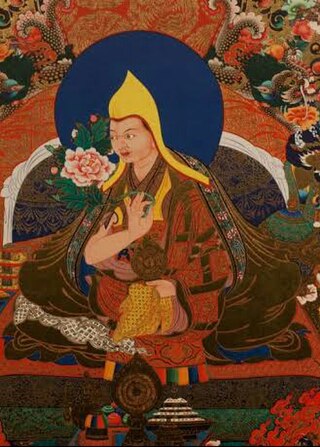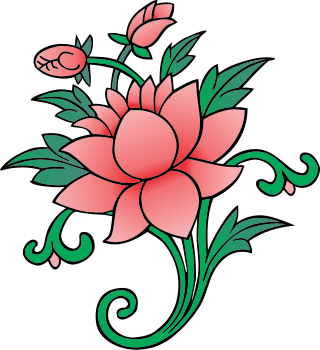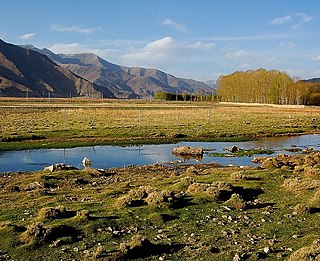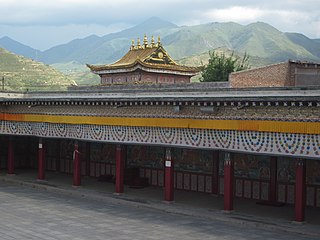| Part of a series on |
| Tibetan Buddhism |
|---|
 |
The Bodongpa or Bodong tradition, is one of the smaller traditions of Tibetan Buddhism falling outside the classification of the four main schools. [1]
| Part of a series on |
| Tibetan Buddhism |
|---|
 |
The Bodongpa or Bodong tradition, is one of the smaller traditions of Tibetan Buddhism falling outside the classification of the four main schools. [1]
Bodong E Monastery (Wylie : bo dong e dgon pa), located in Yutok (Wylie : g.yu thog), in modern Tashigang (Wylie : bkra shis sgang shang), Lhatse County, was the main monastery of the Bodong tradition. [2] It was first established in 1049 by the Kadam (Tibetan Buddhism) teacher Mudra Chenpo (Wylie : bka 'dams pa dge bshes mu tra chen po). [3]
Bodong tradition itself goes back to Bodong Rinchen Tsemo, who received teachings from Drubthob Semo Chewa. Its most renowned figure, often regarded as its founder, was the Bodong Penchen Lénam Gyelchok (Wylie : las rnam rgyal phyogs, 1376-1451), [4] whose seat was at this monastery. Bodong Penchen authored over one hundred and thirty-five volumes and is known as the most prolific writer in Tibetan history. His most famous work is the Compendium of Suchness (Wylie : de nyid 'dus pa) comprising one hundred and thirty-three volumes having about 500 folios (1000 pages) in each. The extensive version contains one hundred and ten volumes; the medium version, twenty volumes; the condensed version, two volumes; and the extremely condensed version, one volume and this encyclopaedic work is considered the foundation of the tradition.
Je Tsongkhapa studied at Bodong E Monastery with the Lotsawa Namkha Zangpo (Wylie : lo tsā ba nam mkha' bzang po), [5] who taught him the Mirror of Poetry (Wylie : snyan ngag me long).
A well-known tulku of this tradition is Samding Dorje Phagmo, one of the few female incarnation lineages of Tibetan Buddhism.
Bodong E Gonpa [2] was almost completely destroyed during the Cultural Revolution [1] though some parts survived because it had been turned into a granary. [6]
Nönga Abbey (Wylie : mngon dga' chos sde), [7] in modern Tingri County, Shigatse, Tibet Autonomous Region.
Chöde Monastery (Wylie : chos sde dgon), Nyêmo County, Lhasa. Founded in 750, converted to the Bodong school in 1250. [8]
Pelmo Chöding (Wylie : dpal mo chos lding) in Nyalam County, Shigatse, Tibet Autonomous Region.
In 1989 the Pelmo Choding monastery (Porong Gompa) in exile was established at Dharamsala, India. [9] A Porong Pelmo Choding monastery has also been built in Kathmandu, Nepal. These monasteries were established by Tibetans from the Porong region of southwest Tibet to preserve the Bodong tradition.

Gedun Drupa was considered posthumously to have been the 1st Dalai Lama.

The Kagyu school, also transliterated as Kagyü, or Kagyud, which translates to "Oral Lineage" or "Whispered Transmission" school, is one of the main schools of Tibetan Buddhism. The Kagyu lineages trace themselves back to the 11th century Indian Mahasiddhas Naropa, Maitripa and the yogini Niguma, via their student Marpa Lotsawa (1012–1097), who brought their teachings to Tibet. Marpa's student Milarepa was also an influential poet and teacher.

The Drukpa or Drukpa Kagyu lineage, sometimes called Dugpa in older sources, is a branch of the Kagyu school of Tibetan Buddhism. The Kagyu school is one of the Sarma or "New Translation" schools of Tibetan Buddhism. The Drukpa lineage was founded in the Tsang region of Tibet by Tsangpa Gyare (1161–1211), and later became influential in Ladakh and Bhutan. It is one of several lineages known as "Red Hat sects".

Nyêmo is a county in the Lhasa west of the main center of Chengguan, Tibet. It lies on the north bank of the Yarlung Tsangpo River, the northern part of the Brahmaputra. The county has an area of 3,276 square kilometres (1,265 sq mi), and as of 2011 had a population of 30,844 people, mostly engaged in agriculture or herding.

Drepung Monastery, located at the foot of Mount Gephel, is one of the "great three" Gelug university gompas (monasteries) of Tibet. The other two are Ganden Monastery and Sera Monastery.

Vajrayoginī is an important figure in Buddhism, especially revered in Tibetan Buddhism. In Vajrayana she is considered a female Buddha and a ḍākiṇī. Vajrayoginī is often described with the epithet sarvabuddhaḍākiṇī, meaning "the ḍākiṇī [who is the Essence] of all Buddhas". She is an Anuttarayoga Tantra meditational deity (iṣṭadevatā) and her practice includes methods for preventing ordinary death, intermediate state (bardo) and rebirth (samsara) by transforming them into paths to enlightenment, and for transforming all mundane daily experiences into higher spiritual paths.

Sakya Monastery, also known as Pel Sakya is a Buddhist monastery situated in Sa'gya Town (ས་སྐྱ་), Sa'gya County, about 127 kilometres (79 mi) west of Shigatse in the Tibet Autonomous Region. The monastery is considered as the seat of the Sakya school of Tibetan Buddhism.

Ngamring County is a county of Xigazê in the Tibet Autonomous Region, China. "Ngamring County, sometimes referred to as the gateway to Mount Kailash and Far West Tibet, is the barren area which divides the Raga Tsangpo and the Brahmaputra."

Xaitongmoin County or Zhetongmön is a county of Xigazê in the Tibet Autonomous Region, China.

Trülku Drakpa Gyeltsen (1619–1656) was an important Gelugpa lama and a contemporary of the 5th Dalai Lama (1617–1682). His Seat was the upper residence of Drepung Monastery, a famous Gelug gompa located near Lhasa.
Karma Gon Monastery, the original monastery of the Karma Kagyu sect of Tibetan Buddhism, was founded in the 12th century by Düsum Khyenpa, the 1st Karmapa Lama in eastern Tibet at the age of 76. Karma Gon, is located on the eastern bank of the Dzachu River in Chamdo, eastern Tibet. Karma Dansa was the cradle of the karma kagyupas. When established the Karmapa had gathered 1000 monks around him here. Karma Gon was named as Karma Dansa as an administrative unit and the Chinese Ming Court enlarged the monastery’s jurisdiction by adding the Mekong’s middle and upper reaches. It was then also called Gama Dansa Si in Chinese.
Samding Monastery "The Temple of Soaring Meditation" is a gompa built on a hill on a peninsula jutting into Yamdrok Lake about 10 kilometres (6.2 mi) east of Nangkatse. It is located 112 kilometres (70 mi) southwest of Lhasa, at an altitude of 4,423 metres (14,511 ft), on a barren hill about 90 metres (300 ft) above the lake at the neck of a narrow peninsula jutting out into the water. It is associated with the Bodong and Shangpa Kagyu schools of Tibetan Buddhism.

In Tibetan Buddhism, Vajravārāhī is a wrathful form of Vajrayogini associated particularly with the Cakrasaṃvara Tantra, where she is paired in yab-yum with the Heruka Cakrasaṃvara. Judith Simmer-Brown writes that "Vajravārāhī's iconography is very similar to that of Vajrayoginī, but she often has more prominent fangs and a more wrathful expression, and she prominently displays a sow's head above her right ear."

Kongpo is a region of central-eastern Tibet, centered in modern Gongbo'gyamda County, Nyingchi Prefecture. It is situated on the Nyang River, a northern tributary of the Yarlung Tsangpo River.

Rongwo Monastery, is a Tibetan Buddhist monastery in Tongren County, Huangnan Tibetan Autonomous Prefecture, Qinghai, China. It is 186 kilometres (116 mi) from Xining.

The Samding Dorje Phagmo is the highest female incarnation in Tibet and the third highest-ranking person in the hierarchy after the Dalai Lama and the Panchen Lama. She was listed among the highest-ranking reincarnations at the time of the 5th Dalai Lama, recognized by the Tibetan government and acknowledged by the emperors of Qing China. In her first incarnation, as Chökyi Drönma, she was the student and consort of the famous polymath Thang Tong Gyalpo, who first identified her as an emanation of Vajravārāhī, and the consort of Bodong Panchen. The seat of the Samding Dorje Phagmo is at Samding Monastery, in Tibet.
The name Karma Chagme refers to a 17th-century Tibetan Buddhist (Vajrayāna) lama and to the tülku lineage which he initiated. Including the first, seven Karma Chagme tülkus have been recognized. The Neydo Kagyu sub-school of the Karma Kagyu was established by the first Karma Chagme, Rāga Asya.
Pagsam Wangpo, a key figure in the history of the Drukpa Lineage of Tibetan Buddhism, was born at Chonggye, in the Tsang province of Tibet a natural son of the prince of Chonggye, Ngawang Sonam Dragpa. He was an elder cousin of the 5th Dalai Lama, Ngawang Lobzang Gyatso (1617-1682).

Nyêmo Chekar monastery ཉེ་མོ་ཆེ་དཀར་དགོན། is a small Buddhist monastery of the Bodongpa tradition in Nyêmo County, Lhasa, Tibet. It is known for its mural paintings of reincarnations of the Samding Dorje Phagmo.

Chökyi Drönma (1422-1455) was a Tibetan princess and Buddhist leader. She was the main consort of Thang Tong Gyalpo, who recognized her as an emanation of Machig Labdrön through the lineage of Vajravārāhī and appointed her as the first Samding Dorje Phagmo.